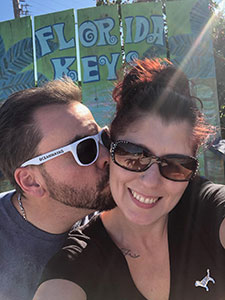We moved from the Midwest to Escape cold winters, wait Florida gets cold too?

We were actually cold at the beach and going snorkeling at Thanksgiving.
I’m South Dakota born and raised. Looking back, I don’t think I’d really change much other than relocating to Florida sooner. The upper Midwest summers are hot and very humid. Winters will make a man out of you. With wind chill, a bad night can hit 100 degrees below zero. Then there’s the snow, ice and slush that refreezes overnight. I don’t know how the pioneers or Native Americans made it burning wood as a heating source. Growing up, my parent’s house had a fireplace and it was used as more of a novelty in the fall or mild winter nights. The rest of the season, that furnace was burning natural gas.
When Faith and I decided to relocate to Jacksonville, Florida, we donated most of our winter gear instead of packing it. We both figured most days we’d be in shorts and soaking up the sun at the beach. The first year we were in Florida, it was a pretty mild winter and there were a few jeans and light jacket days. Then we acclimated and understood our second Florida winter, why we saw people in quilted coats. But we still spent Thanksgiving at Key West and Christmas on the beach.
Havana, Florida’s winters is nothing like Jacksonville.
The northern region of Florida’s panhandle experiences occasional cold spells. In 2021, during our first year here, we encountered one or two instances of severe cold snaps. In 2022, we were greeted by a frigid morning with temperatures as low as nine degrees, accompanied by several nights of hard freezes. Now, it appears that 2023 is shaping up to be even colder.
Compared to the heating systems found up north, the furnaces installed in most homes in the southern parts of the state seem quite inadequate. However, the reality is that the extreme heating needs aren’t necessary here. Last year, we decided to utilize our farmhouse fireplace to warm our entire house, setting the thermostat at 50 degrees. Aside from particularly chilly nights, we managed without relying on the electric heating system in our home.
While our fireplace, which we lit in the morning and kept burning throughout the day, served us well, it did lead to a impressive consumption of firewood. I was unprepared for the extent of our firewood usage. We cut down some trees and prepared them for use as firewood. A neighbor gave us a small firewood rack, which held roughly half a face cord of wood. I also constructed a second rack from reclaimed lumber to accommodate the overflow of wood, thinking that we would have enough firewood for years. Unfortunately, we ended up purchasing an entire pickup load of firewood before the month of December came to a close.
Florida winters are still way better than South Dakota
North Florida experiences noticeable cold weather during the winter months, a departure from the state’s typical warm and temperate climate. While the southern regions of Florida maintain milder temperatures during this season, the northern areas, including the panhandle, can see frosty conditions then jump back to the 80’s. Cold snaps with freezing temperatures and occasional hard freezes are not uncommon. Residents often have to adapt by using their furnaces and turning to traditional sources of warmth, such as fireplaces, to keep comfortable during the colder months. These winter fluctuations in temperature are a reminder that Florida’s climate can vary significantly from the tropical and subtropical conditions the state is renowned for.


